Class 9 Maths Chapter 7 Practice Question Answers - Coordinate Geometry
Q1: The abscissa of all the points on the x-axis is:
(a) 0
(b) 1
(c) 2
(d) Any number
Ans: (d)
The coordinate of any point in the x-axis is (x,0), where x can take any value.
So, abscissa of any point on the x-axis is any number.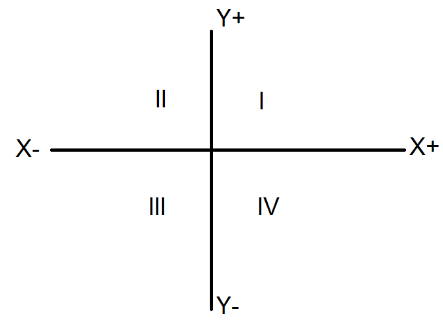 Hence, we can say that, abscissa of all the points on the x-axis is any number because x - axis is a number line which contains infinite real numbers on it.Therefore, (D) is correct.
Hence, we can say that, abscissa of all the points on the x-axis is any number because x - axis is a number line which contains infinite real numbers on it.Therefore, (D) is correct.
Q2: Points (1,1), (2,2), (4,5), (3,4) lie
(a) In II quadrant
(b) In III quadrant
(c) In IV quadrant
(d) In I quadrant.
Ans: (d)
Given points are (1,1),(2,2),(4,5),(3,4)
Both the coordinates of given points are positive.
If both the coordinates are positive, then the points lie in I quadrant.
Thus, the given points lie in I quadrant.
Hence, option D is correct.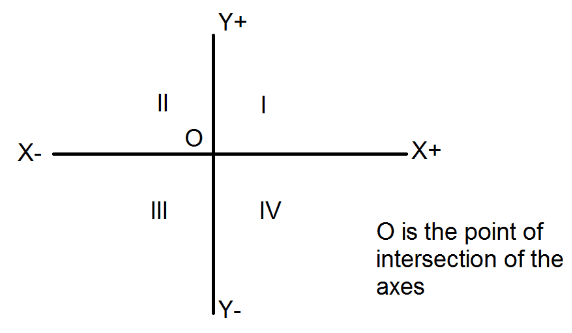
Q3: The points (5,2) and (2,5) lie in the
(a) Same quadrant
(b) II and III quadrants respectively
(c) II and IV quadrants respectively
(d) IV and II quadrants respectively
Ans: (a)
The points are (5,2) and (2,5).
The signs of the abscissae are same (positive) and the signs of the ordinates are same (positive).
Therefore, they both lie in the first quadrant (same quadrant).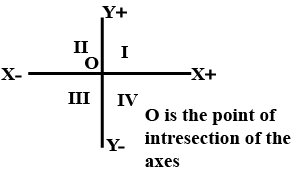
Q4: If y coordinate of a point is zero, then this point always lies:
(a) In I quadrant
(b) In II quadrant
(c) On x-axis
(d) On y-axis
Ans: (c)
Given, the y-coordinate is zero.
∴ the abscissa can be any number x and the ordinate is 0.
Then, the point is (x,0), when x may take any value, i.e. x may take positive or negative value.
∴ the point (x,0) lies on the x axis.
Therefore, option C is correct.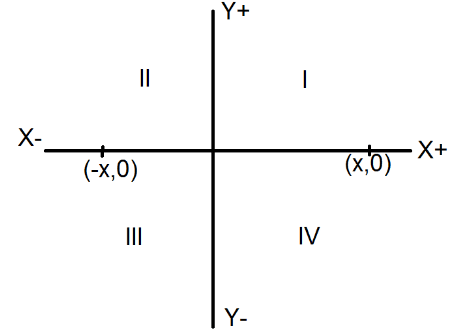
Q5: The point at which the two coordinate axes meet is called the
(a) Abscissa
(b) Ordinate
(c) Origin
(d) Quadrant
Ans: (c)
The point at which the coordinate axes meet is called the origin. The point is denoted by O in the above image.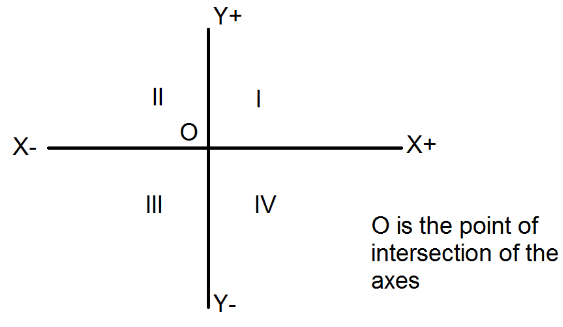
Q6: The point (10,0) lies:
(a) To the positive direction and on the x-axis
(b) On the negative direction of the y-axis
(c) In the third quadrant
(d) In the fourth quadrant
Ans: (a)
The coordinates of the given point are (10,0), i.e. the ordinate is 0.
We know, the coordinates of a point in the form (x,0) lies in the x-axis.
∴(10,0) lie on the x-axis.
Here, the abscissa is 10, and is positive.
∴ (10,0) lies on the positive direction of the x-axis.
Therefore, option A is correct. Q7: Ordinate of all points on the x-axis is:
Q7: Ordinate of all points on the x-axis is:
(a) 0
(b) 1
(c) −1
(d) Any number
Ans: (a)
We know, the coordinates of x-axis is (x,0).
Then, the coordinates of any point on the x-axis is (x,0),
where the abscissa is x and the ordinate is 0.
Therefore, the ordinate of any point on the x-axis is 0.
Hence, option A is correct.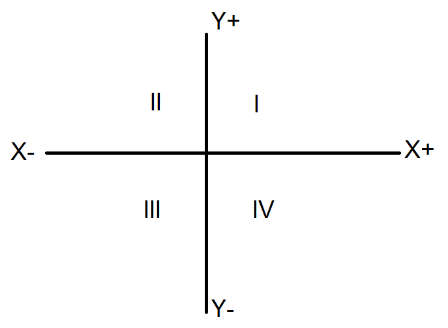
Q8: A point both of whose coordinates are negative will lie in
(a) I quadrant
(b) II quadrant
(c) III quadrant
(d) IV quadrant
Ans: (c)
In the third quadrant the (x,y) co-ordinates are negative,
So, the given point will lie in the third quadrant.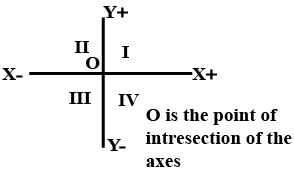
Q9: In which quadrant the point (2,−3) will lie?
(a) First
(b) Second
(c) Third
(d) Fourth
Ans: (d)
Given point is (2,−3)
Since x−coordinate is positive and y−coordinate is negative, the given point will lie in the fourth quadrant.
Hence, option D is correct.
Q10: Which of the points P(0,3),Q(1,0),R(0,1),S(5,0),T(1,2) do not lie on the x-axis?
(a) P and R only
(b) Q and S only
(c) P,R and T
(d) Q,S and T
Ans: (c)
Any point which do not lie on the x− axis has coordinates of the form (x,y), where y≠0
From the given points,
in P(0,3), y=3≠0,
in Q(1,0), y=0,
in R(0,1), y=1 ≠0,
in S(5,0), y=0 and
in T(1,2), y=2≠0.
We can see that, the coordinates of points P,R and T have y = 0.
Thus, P,R and T do not lie on the x− axis.
Hence, option C is correct.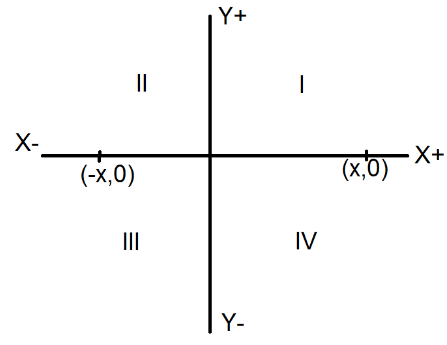
Q11: If P(1,1),Q(−3,−4),R(−1,−1),S(2,3) and T(4,4) are plotted on the graph paper, then the point(s) in the third quadrant are:
(a) P and T
(b) Q and R
(c) Only S
(d) P and R
Ans: (b)
We know that in third quadrant both the coordinates i.e, x,y are negative.
Now the given points are
P(1,1),Q(−3,−4),R(−1,−1),S(2,3) and T(4,4).
Among them, Q and R have both the coordinates negative.
∴ points Q and R are in third quadrant.
Q12: The point (3,5) lies in which quadrant in the Cartesian coordinate plane?
(a) first quadrant
(b) second quadrant
(c) third quadrant
(d) fourth quadrant
Ans: (a)
Since, the x-coordinate and the y-coordinate are both positive, the point (3,5) lies in the first quadrant of the Cartesian plane.
Therefore, option A is correct.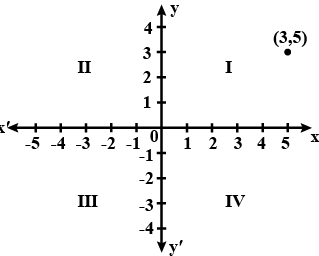
Q13: The points whose abscissa and ordinate have different signs will lie in:
(a) I and II quadrants
(b) II and III quadrants
(c) I and III quadrants
(d) II and IV quadrants
Ans: (d)
A coordinate is an ordered pair of numbers in which the first number is the abscissa i.e. the measurement along the X axis and the second number is the ordinate i.e, the measurement along the Y axis.
The signs of the coordinates in the first quadrant is (+,+),
the second quadrant is (−,+),
the third quadrant is (−,−),
fourth quadrant is (+,−).
So, the points whose abscissa and ordinate have different signs are 2nd and 4th quadrants.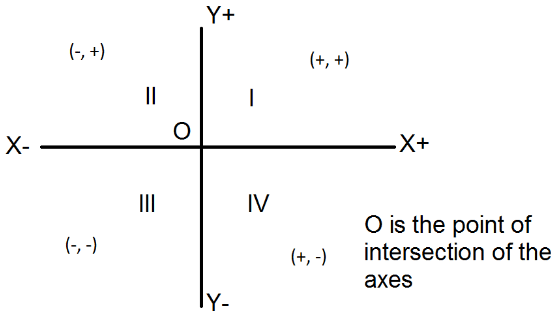
Q14: Abscissa of a point is positive in
(a) I and II quadrants
(b) I and IV quadrants
(c) I quadrant only
(d) II quadrant only
Ans: (b)
Step -1: The signs of the quadrants are as follows: As we know that,
As we know that,
Coordinate is an ordered pair of number in which the first number is the abscissa
i.e. the measurement along the X - axis.
So, from the above diagram we can observe that abscissa is positive in 1st and 4th quadrants.
Hence, option B is the correct answer.
Q15: Signs of the abscissa and ordinate of a point in the second quadrant are respectively:
(a) +,+
(b) −,−
(c) −,+
(d) +,−
Ans: (c)
Step -1: Drawing coordinate plane. Step -2: Finding the signs in second quadrant.
Step -2: Finding the signs in second quadrant.
As in the figure, we can clearly see that the second quadrant lies between the postive y-axis and the negative x-axis.
So, in the quadrant, abscissa is negative and ordinate is positive, i.e., (−,+)
Hence, The correct option is C.
Q16: In which quadrant or on which axis each of the following points lie?
(−3,5),(4,−1),(2,0),(2,2),(−3,−6)
(a) IV, II, x-axis, I, III
(b) II, IV, x-axis, I, III
(c) IV, III, I, I, III
(d) II, IV, y-axis, I, III
Ans: (b)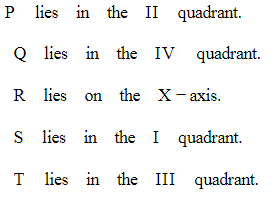
Q17: What is the quadrilateral that is formed by joining the points (1, 1); (2, 4); (8, 4) and (10, 1)?
(a) A triangle
(b) A square
(c) A rectangle
(d) A trapezium
Ans: (d)
Given : quadrilateral vertices are (1,1), (2,4), (8,4) and (10,1).
To find : Draw quadrilateral and find type of Quadrilateral
quadrilateral whose vertices are (1,1), (2,4), (8,4) and (10,1).
Given Quadrilateral is a trapezium
Slope of line between (2,4) (8,4) & Length = 6
= (4 - 4)/(8 - 2)
= 0/6
= 0
Slope of line between (10,1). & (1,1), & Length = 9
= ( 1 - 1)/(10 - 1)
= 0/9
= 0
Length of line line joining {(2,4), (8,4)}=(8−2)=6
Length of line line joining {(1,1), (10,1)}=(10−1)=9
Hence Two unequal Sides are parallel.
Q18: Find the quadrant in which the following point lie: A(7,−3)
Ans: A(7,−3).
As the x co-ordinate is positive and y− co-ordinate is negative so the point lies in fourth quadrant.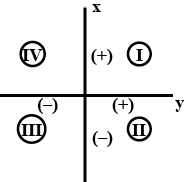
Q19: What are the coordinates of point A on the following graph?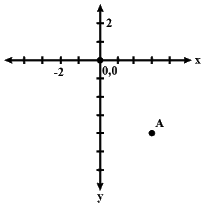 (a) (-3, -4)
(a) (-3, -4)
(b) (-4, 3)
(c) (3, -4)
(d) (-4, -3)
Ans: (c)
Clearly, from the following graph, it can be induced that:
3 lies on x axis, and −4 on y- axis.
Hence, coordinates of A are (3,−4), option C.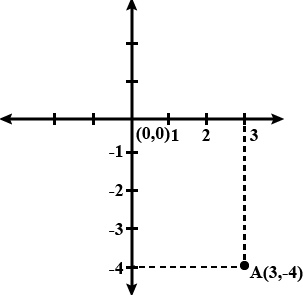
Q20: In what ratio is the line segment joining (−2,4) and (−3,2) divided by the line x−y=5?
Ans: The given line is x−y=5 ..........(1)
Let the line (1) divide the line segment joining the point (−2,4) and (−3,2) at the point P in the ratio k:1 then the co-ordinates of point P are
Since P lies on (1), we get
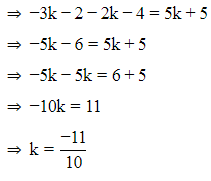
Hence, the required ratio is -11/10 : 1 or 11 : 10 externally.
Q21: Plot the point (0,2) on a graph paper.
Ans: In the given point (0,2), the x-coordinate is zero and the y-coordinate is positive.
Therefore, it lies on the positive y-axis as shown in the graph.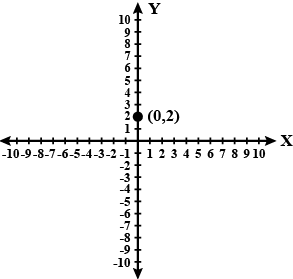
Q22: Plot the point (−5,4) on a graph paper.
Ans: In the given point (−5,4), the x-coordinate is negative and the y-coordinate is positive.
Therefore, it lies in the IInd quadrant as shown in the graph.
Q23: Plot the point (−3,−4) on a graph paper.
Ans: In the given point (−3,−4), the x - coordinate is negative and the y - coordinate is negative.
Therefore, it lies in the IIIrd quadrant as shown in the graph.
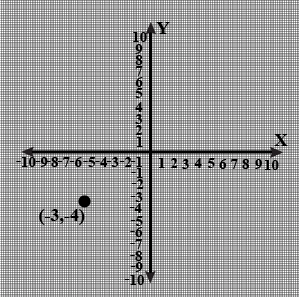
Q24: Given below are some points, with their co-ordinates.
$$P(4, 3), Q(-3, 2), R(5, 1), S(0, -4)$$What is the x-co-ordinate of point S ?
Ans: We know, any point in the xy cartesian plane, is denoted by (x−coordinate,y−coordinate)
The point S is given as S(0,−4).
Hence, x−coordinate of point S is 0.
Q25: State on which axis or quadrant the following points belong:
M(−3,−5),N(2,0),S(0,−5),K(−2,3),T(4,0),E(7,8),F(0,1),O(0,0).
Ans: We know,
Point (a,b) lies on the:
x-axis if b=0
y-axis if a=0.
Also, the given point lies in the:
First quadrant, if a>0 and b>0,
Second quadrant, if a<0 and b>0,
Third quadrant, if a<0 and b<0 and
Fourth quadrant, if a>0 and b<0.
Here,
Quadrant I : E(7,8),
Quadrant II : K(−2,3),
Quadrant III: M(−3,−5),
Y-axis = F(0,1) and S(0,−5),
X-axis = N(2,0) and T(4,0) and
Origin = (0,0).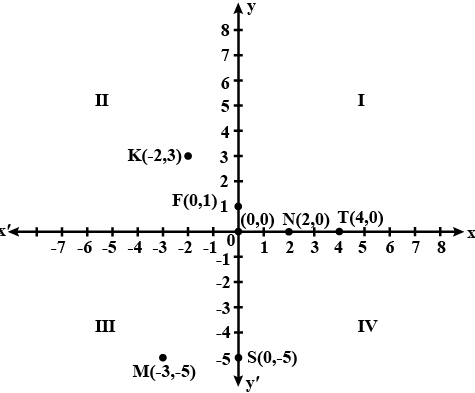
|
40 videos|471 docs|57 tests
|





















